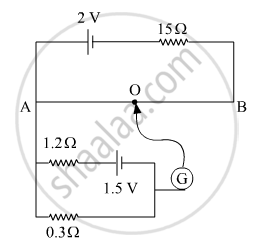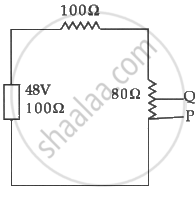Advertisements
Advertisements
प्रश्न
Describe the working principle of a solar cell. Mention three basic processes involved in the generation of emf.
उत्तर
Solar cell is a p-n junction device which works on the principle of conversion of solar energy into electrical energy by generating emf. The generation of emf by a solar cell when light falls on it is due to following three processes:
- The upper layer of p-type semiconductor is made very thin so that the incident light photons may easily reach the p-n junction.
- When the photon of light of energy greater than forbidden energy gap (
\[h\nu > E_g\]is incident on a p-n junction, electron-hole pairs are generated in the depletion layer.
- The photo-generated electrons reaching the n-side of p-n junction . The photo generated holes reaching the p-side are of p-n junction. Thus, the p-side becomes positively charged and the n-side becomes negatively charged, giving rise to photovoltage.
APPEARS IN
संबंधित प्रश्न
In the following potentiometer circuit, AB is a uniform wire of length 1 m and resistance 10 Ω. Calculate the potential gradient along the wire and balance length AO (= l).

When 5 V potential difference is applied across a wire of length 0.1 m, the drift speed of electrons is 2.5 x 10-4 m/s. If the electron density in the wire is 8 x 1028 m-3, calculate the resistivity of the material of the wire.
The current in a conductor and the potential difference across its ends are measured by an ammeter and a voltmeter. The meters draw negligible currents. The ammeter is accurate but the voltmeter has a zero error (that is, it does not read zero when no potential difference is applied). Calculate the zero error if the readings for two different conditions are 1.75 A, 14.4 V and 2.75 A, 22.4 V.
The potential difference between the terminals of a battery of emf 6.0 V and internal resistance 1 Ω drops to 5.8 V when connected across an external resistor. Find the resistance of the external resistor.
A 6-volt battery of negligible internal resistance is connected across a uniform wire AB of length 100 cm. The positive terminal of another battery of emf 4 V and internal resistance 1 Ω is joined to the point A, as shown in the figure. Take the potential at B to be zero. (a) What are the potentials at the points A and C? (b) At which point D of the wire AB, the potential is equal to the potential at C? (c) If the points C and D are connected by a wire, what will be the current through it? (d) If the 4 V battery is replaced by a 7.5 V battery, what would be the answers of parts (a) and (b)?

The potential difference across the terminals of a battery of emf 12 V and internal resistance 2 Ω drops to 10 V when it is connected to a silver voltameter. Find the silver deposited at the cathode in half an hour. Atomic weight of silver is 107.9 g mol−1.
In the circuit in figure the potential difference across P and Q will be nearest to

Two sources of equal e.m.f are connected to an external resistance R in series. The internal resistance of the two sources are R1 and R2 (R2 > R1) If the potential difference across the source having internal. resistance R2 is zero, then ______.
The terminal potential difference of a cell is greater than its e.m.f when it is ______
